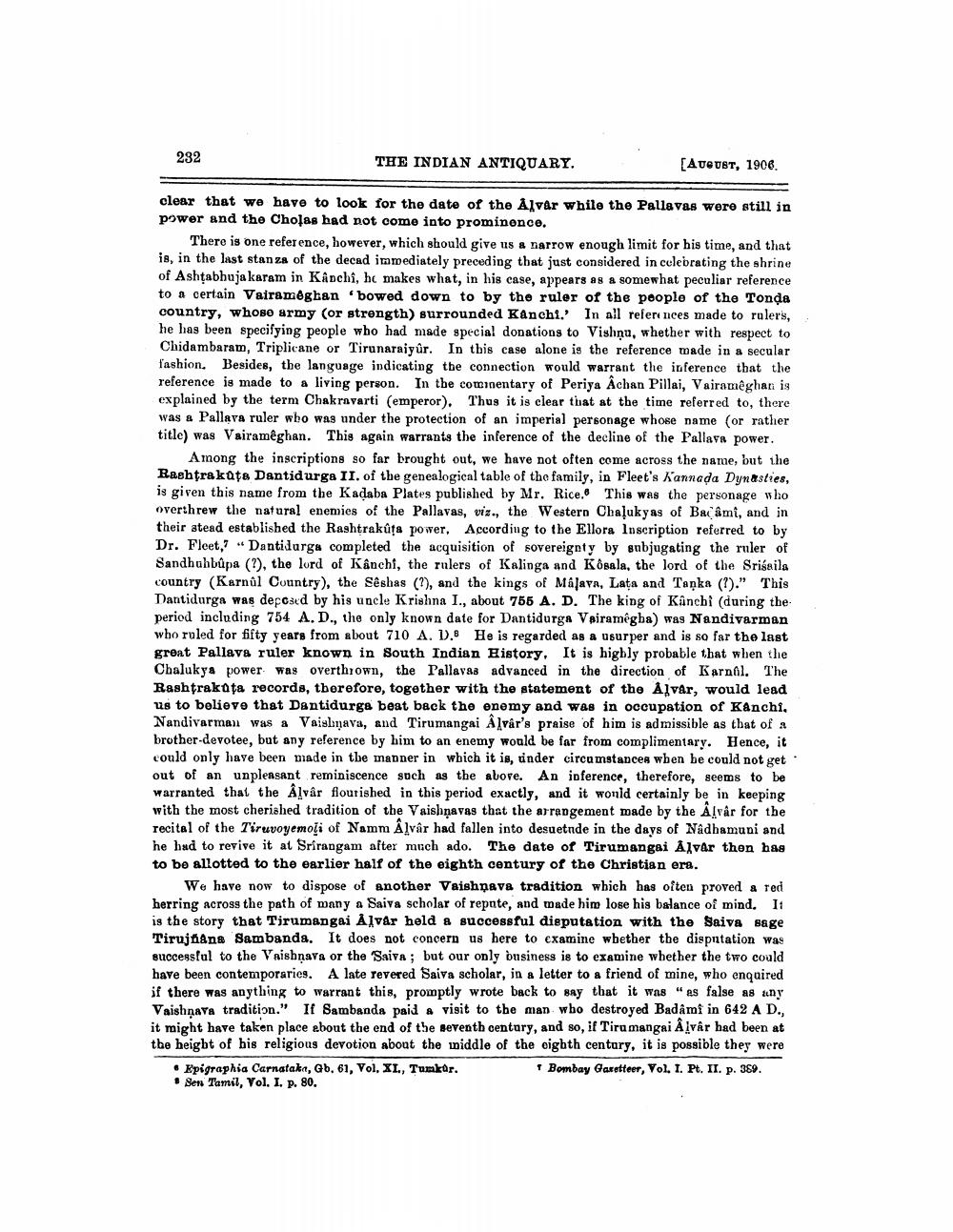________________
THE INDIAN ANTIQUARY.
clear that we have to look for the date of the Alvar while the Pallavas were still in power and the Cholas had not come into prominence.
232
[AUGUST, 1906.
There is one reference, however, which should give us a narrow enough limit for his time, and that is, in the last stanza of the decad immediately preceding that just considered in celebrating the shrine of Ashtabhuja karam in Kânchi, he makes what, in his case, appears as a somewhat peculiar reference to a certain Vairamêghan 'bowed down to by the ruler of the people of the Tonda country, whose army (or strength) surrounded Kanchi.' In all references made to rulers, he has been specifying people who had made special donations to Vishnu, whether with respect to Chidambaram, Triplicane or Tirunaraiyûr. In this case alone is the reference made in a secular fashion. Besides, the language indicating the connection would warrant the inference that the reference is made to a living person. In the commentary of Periya Achan Pillai, Vairamêghan is explained by the term Chakravarti (emperor). Thus it is clear that at the time referred to, there was a Pallava ruler who was under the protection of an imperial personage whose name (or rather title) was Vairamêghan. This again warrants the inference of the decline of the Pallava power.
Among the inscriptions so far brought out, we have not often come across the name, but the Rashtrakuta Dantidurga II. of the genealogical table of the family, in Fleet's Kannada Dynasties, is given this name from the Kadaba Plates published by Mr. Rice. This was the personage who overthrew the natural enemies of the Pallavas, viz., the Western Chalukyas of Bacâmî, and in their stead established the Rashtrakuta power, According to the Ellora Inscription referred to by Dr. Fleet, Dantidurga completed the acquisition of sovereignty by subjugating the ruler of Sandhuhbûpa (?), the lord of Kânchi, the rulers of Kalinga and Kôsala, the lord of the Srisaila country (Karnûl Country), the Sêshas (?), and the kings of Malava, Lata and Tanka (?)." This Dantidurga was deposed by his uncle Krishna I., about 755 A. D. The king of Kanchi (during the period including 754 A. D., the only known date for Dantidurga Vairamêgha) was Nandivarman who ruled for fifty years from about 710 A. D. He is regarded as a usurper and is so far the last great Pallava ruler known in South Indian History. It is highly probable that when the Chalukya power was overthrown, the Pallavas advanced in the direction of Karnal. The Rashtrakuta records, therefore, together with the statement of the Alvar, would lead us to believe that Dantidurga beat back the enemy and was in occupation of Kanchi. Nandivarman was a Vaishnava, and Tirumangai Alvar's praise of him is admissible as that of a brother-devotee, but any reference by him to an enemy would be far from complimentary. Hence, it could only have been made in the manner in which it is, under circumstances when he could not get out of an unpleasant reminiscence such as the above. An inference, therefore, seems to be warranted that the Alvâr flourished in this period exactly, and it would certainly be in keeping with the most cherished tradition of the Vaishnavas that the arrangement made by the Alvår for the recital of the Tiruvoyemoli of Namm Alvâr had fallen into desuetude in the days of Nâdhamuni and he had to revive it at Srirangam after much ado. The date of Tirumangai Alvar then has to be allotted to the earlier half of the eighth century of the Christian era.
We have now to dispose of another Vaishnava tradition which has often proved a red herring across the path of many a Saiva scholar of repute, and made him lose his balance of mind. It is the story that Tirumangai Alvar held a successful disputation with the Saiva sage Tirujñana Sambanda. It does not concern us here to examine whether the disputation was successful to the Vaishnava or the Saiva; but our only business is to examine whether the two could have been contemporaries. A late revered Saiva scholar, in a letter to a friend of mine, who enquired if there was anything to warrant this, promptly wrote back to say that it was "as false as any Vaishnava tradition." If Sambanda paid a visit to the man who destroyed Badâmi in 642 A D., it might have taken place about the end of the seventh century, and so, if Tirumangai Alvâr had been at the height of his religious devotion about the middle of the eighth century, it is possible they were
↑ Bombay Gazetteer, Vol. I. Pt. II. p. 389.
Epigraphia Carnataka, Gb. 61, Vol. XI., Tumkur. Sen Tamil, Vol. I. p. 80.




